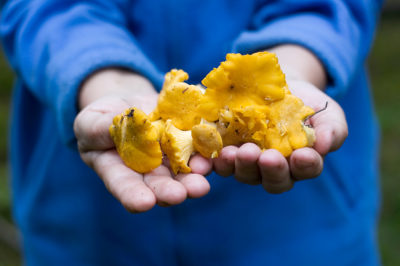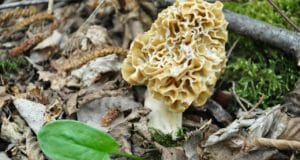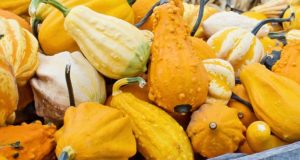Mushrooms offer unique flavor and texture to a variety of dishes. Whether they are enjoyed fresh, steamed, grilled, or sautéed with a little bit of garlic, mushrooms are a kitchen staple that the majority of us can agree on. With such a vast selection of edible mushrooms available to us, there are almost endless opportunities to explore new dishes and flavor combinations. The major downside to these delectable little fungus staples is that mushrooms can be incredibly expensive to buy, especially if you’d like to branch out from the usual button and portabella mushrooms that are typically the only types offered at grocery stores.
Certainly we’ve all seen the gorgeous white and brown mushrooms popping up on our properties on cooler mornings, but we’ve all also likely been warned about the dangers of picking wild mushrooms. The truth is that unless you are truly an expert about all things mushroom, it is never advisable to pick any mushrooms you find growing on your property, as they can make you incredibly ill or just outright kill you. (Perhaps the only exception to this rule would be the unmistakable oyster mushrooms. There is only one other thing that could be mistaken for an oyster mushroom and it is the shelf fungus. Shelf fungus isn’t exactly toxic, but it will likely break your teeth before you are even able to ingest it, because it is as hard as a rock.)
In general, it really isn’t that cost-effective to grow your own mushrooms if you are purchasing the spores needed from a small boutique mushroom seller. To find the nearest suppliers of spores for your area, it is advisable to contact your local extension office. They can help to guide you towards local growers and sellers who can help you get started.
Growing Medium
Mushroom farming requires a medium for your mushrooms to grow in. There may be a lot of jokes about mushrooms and manure, but the truth is that manure and composted manure provide the necessary nutrients that mushrooms need in order to grow and thrive. Countless mushroom growers have learned that horse manure combined with wheat straw is the best combination to ensure productive and healthy mushroom growth.
Strictly speaking however, horse manure is not needed in order to get mushrooms to grow. Nitrogen supplements can be added to a growing medium of crushed corncobs, gypsum, and hay, in order to produce an excellent bed for the fungus to thrive.
Do some research into what growing mediums have been most successful in your area; again, your local extension office can again prove helpful with this information. Keep in mind that some types of mushrooms require extensive preparation, while others are quite content to simply grow on a log or in a bell jar in your kitchen.
The Six Steps Of Growing Mushrooms
There are typically six steps to growing mushrooms, but if you aren’t planning on growing large mushroom crops right away then you might find it a lot easier to simply purchase spawning kits from a mushroom boutique website. These aren’t always the most cost-effective choice, but they can help you to learn more about how mushrooms grow and what to expect once you ultimately branch out.
The six steps of growing mushrooms include the following:
- Compost preparation
- Compost readiness
- Spawning the mushrooms
- Casing
- Pinning
- Cropping
As a general rule, if the conditions are ideal for it, it should take 45 days from start to harvest of the mushrooms. There are a number of varieties that have been known to grow so rapidly that the mushrooms are growing outside of the box once the spore plugs arrive via courier.
Let’s cover a bit of each of the six steps of mushroom growing so that you can better understand how to get your compost preparation underway.
The first phase requires getting the compost mixture and growing medium just right in order to create a hospitable environment for the mushrooms to grow. A concrete slab is preferred for composting, as you will need to aerate, water, and turn the compost over several times before spawning. While today a tractor and compost turner are used on large-scale operations, you may find that a pitchfork is the best choice for your mushroom patch, since you are unlikely to have an acre of mushrooms to work. This can also be done inside of a compost drum or barrel, especially if it has a handle and can be rotated well.
Whether you are using synthetic compost or horse manure, it is important to soak the compost with water and then add a good amount of gypsum and nitrogen supplements. Once combined and turned, the compost pile will start the process of aerobic fermentation – which is the fancy term for composting. Carbon dioxide, ammonia, and heat are byproducts of aerobic fermentation, which can often result in an unpleasant odor.
As the ingredients are converted through the process of composting, you’ll result in a material that is perfectly suited for growing mushrooms. So long as there is plenty of nitrogen, oxygen, and moisture available, your compost will continue to process. Aerate it every two days by turning it in the compost drum or by turning it with a pitchfork. The temperature within your compost pile should maintain at least 145 degrees Fahrenheit. If it is not yet at this ideal temperature, then you may need to add additional straw and nitrogen to the pile.
The first step should last anywhere from seven to fourteen days, with the ultimate result being a brown-colored compost that has a moisture content of at least 68 percent, and an incredibly strong ammonia smell.
Finishing out the compost is a step that essentially pasteurizes the compost in order to destroy unwanted insects, nematodes, and pest fungi. It will also help to remove a significant amount of the ammonia that formed during the first step. If the levels of ammonia are not controlled, then you will be providing a growing medium that is actually toxic to mushroom spawn.
Large plastic trays are filled with the compost and are then set out in an area that will encourage positive airflow. The temperature should be at least 110 degrees Fahrenheit, and there should be plenty of air movement, which often makes a greenhouse or garage a great choice, so long as there are windows open allowing for the movement of the air. Every two days the compost should be turned in order to encourage additional aeration, which will also encourage the growth of organisms that thrive on ammonia present in the compost.
Some mushroom farmers cover their compost trays with plastic sheeting and use steam to heat up the interior of their shed or greenhouse, often to temperatures that exceed 130 degrees Fahrenheit. This is very efficient because it encourages rapid growth of the organisms that will pull the ammonia out of the compost, and it will remove any pests that are present in the compost.
The ultimate temperature of the compost should be in the 75 degrees Fahrenheit range, which can take a few days of aeration and turning to achieve. The resulting compost should also be dry, loose, and not have an overwhelmingly strong odor of ammonia.
The Best Fertilizer For Your Organic Garden Is Compost…
With mushroom spawn plugs in hand, you can distribute the spawn across the compost, thoroughly mixing it in order to ensure even distribution. Temperatures should be maintained at 75 degrees, with a high relative humidity, in order to avoid the compost drying out and thus killing the spawn before it produces mushrooms. Temperatures in the compost will start to increase as the mushrooms start to grow, but it can be a tricky thing to maintain the ideal temperature, so it is best to have a temperature controlled environment in which to grow mushrooms. It can take up to 14 days to start to see progress with your mushroom spawn.
The next step is to apply a top dressing to the spawn-laden compost as a medium onto which the mushrooms will actually form. Powdered limestone and peat moss, or sandy loam soil are popular choices that are spread out on top of the compost. It is not necessary for the casing to have nutrients in it, as it simply acts as a medium for water retention, which makes it essential that the casing be able to hold water. The relative humidity should be kept at high levels in order to encourage the mushrooms to start to do what is known as pinning.
Pinning is the step where the mushrooms actually start to form. Small pin-like structures will be seen sprouting through on the casing and within 20 days you should have harvestable mushrooms present. It can actually be somewhat tricky to get the pins to form effectively, because it requires the introduction of fresh air and a lowering of the temperature and relatively humidity.
Cropping, or harvesting, is done in 3 to 5 day periods that are then followed by several days where there is nothing ready to harvest. Don’t give up on your mushrooms just yet, as you’ll soon find new pinning occurring, and entirely new crop of mushrooms developing. From one batch of compost, you could harvest mushrooms for up to two months if conditions are ideal.
It may seem like a lot of work to grow mushrooms, but it is important to note that there are numerous kits and supplies that can shorten the process drastically. It all depends on just how much you are willing to invest in the process to get the best results. There is a lot of trial and error involved in growing mushrooms, but once you have the hang of it, and have the guidance of a professional, you’ll soon find that you have plenty of fresh mushrooms to enjoy year-round.
 Off The Grid News Better Ideas For Off The Grid Living
Off The Grid News Better Ideas For Off The Grid Living





